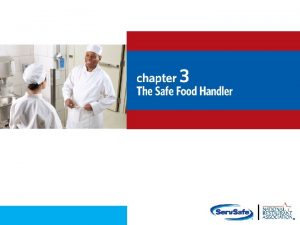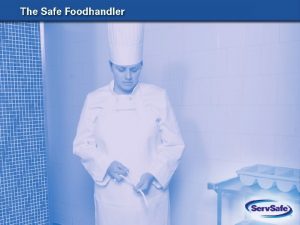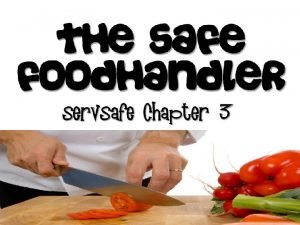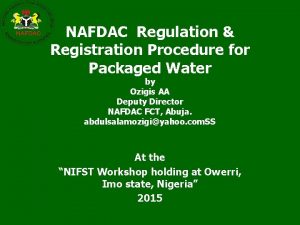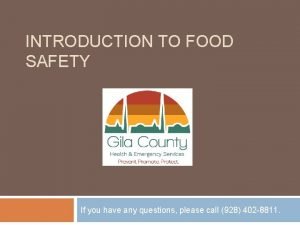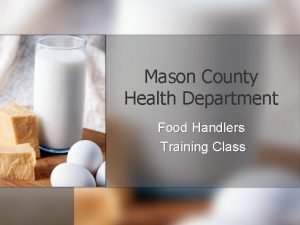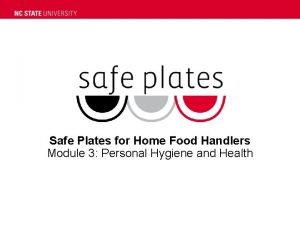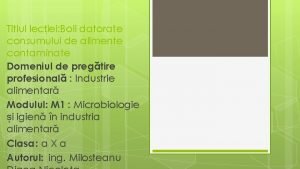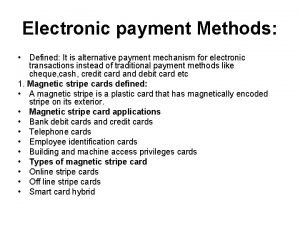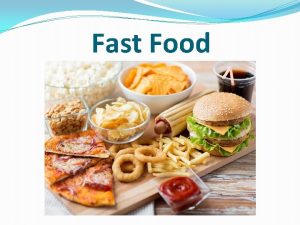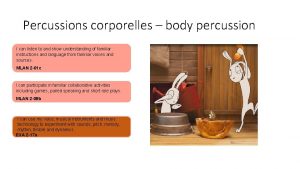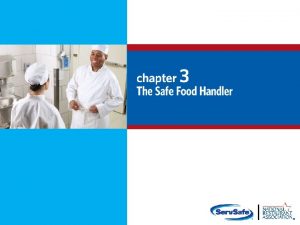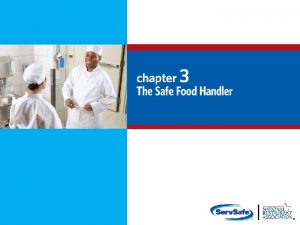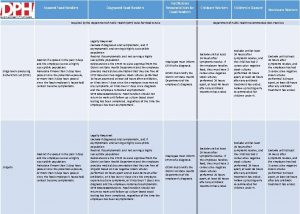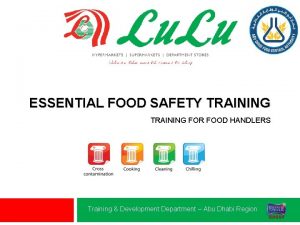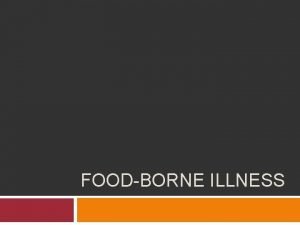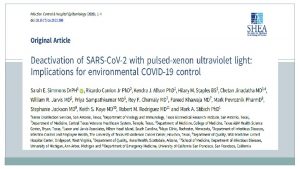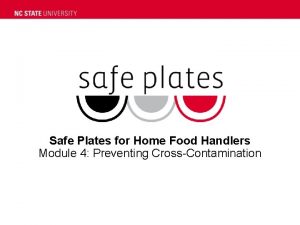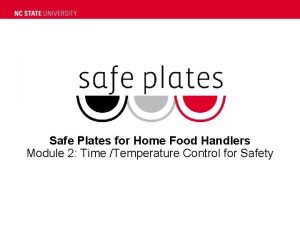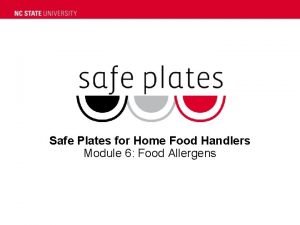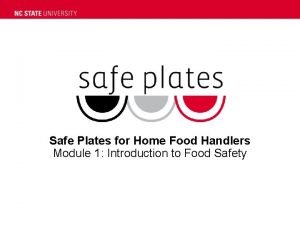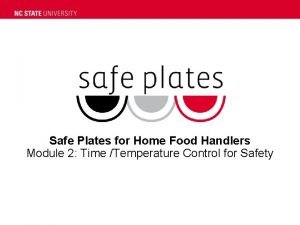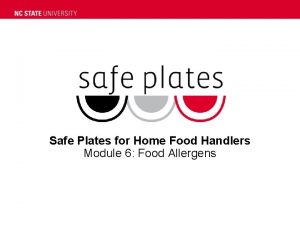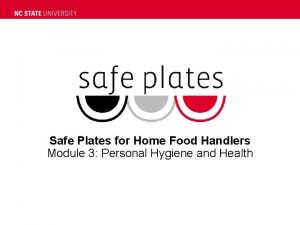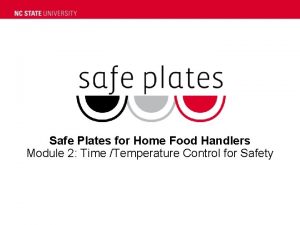How Food Handlers Can Contaminate Food handlers can


























- Slides: 26


How Food Handlers Can Contaminate Food handlers can contaminate food when they: 3 -5 l Have a foodborne illness l Have wounds that contain a pathogen l Sneeze or cough l Have contact with a person who is sick l Touch anything that may contaminate their hands and don’t wash them l Have symptoms such as diarrhea, vomiting, or jaundice—a yellowing of the eyes or skin

Managing a Personal Hygiene Program Managers must focus on the following: 3 -6 l Creating personal hygiene policies l Training food handlers on personal hygiene policies and retraining them regularly l Modeling correct behavior at all times l Supervising food safety practices l Revising personal hygiene policies when laws or science change

Infected Wounds or Cuts Infected wounds or cuts: l Contain pus l Must be covered to prevent pathogens from contaminating food and food-contact surfaces How a wound is covered depends on where it is located: 3 -7 l Cover wounds on the hand or wrist with an impermeable cover, (i. e. bandage or finger cot) and then a single-use glove l Cover wounds on the arm with an impermeable cover, such as a bandage l Cover wounds on other parts of the body with a dry, tight-fitting bandage

Single-Use Gloves Single-use gloves: l 3 -8 Should be used when handling ready-to-eat food o Except when washing produce o Except when handling ready-to-eat ingredients for a dish that will be cooked l Must NEVER be used in place of handwashing l Must NEVER be washed and reused l Must fit correctly l Approved gloves ONLY l Single-Use Disposable Gloves

Single-Use Gloves How to use gloves: l l l l Wash and dry hands before putting gloves on Select the correct glove size Hold gloves by the edge when putting them on Once gloves are on, check for rips or tears NEVER blow into gloves NEVER roll gloves to make them easier to put on Change Gloves: o 3 -9 Dirty, torn, before starting another task, after an interruption (cell phone), after handling raw meat, seafood, poultry, or ready-to-eat food

Bare-Hand Contact with Ready-to-Eat Food Bare-hand contact with ready-to -eat food must be avoided: l l 3 -10 Some jurisdictions allow it but require o Policies on staff health o Training in handwashing and personal hygiene practices NEVER handle ready-to-eat food with bare hands when you primarily serve a high-risk population

Handling Staff Illnesses If: The food handler has a sore throat with a fever Then: ● Restrict the food handler from working with or around food ● Exclude the food handler from the operation if you primarily serve a highrisk population ● A written release from a medical practitioner is required before returning to work 3 -11

Handling Staff Illnesses If: The food handler has at least one of these symptoms ● Vomiting ● Diarrhea Then: ● Exclude the food handler from the operation ● Before returning to work, food handlers who vomited or had diarrhea must meet one of these requirements 3 -12 o Have had no symptoms for at least 24 hours o Have a written release from a medical

Handling Staff Illnesses If: The food handler has jaundice Then: ● Food handlers with jaundice must be reported to the regulatory authority ● Exclude food handlers who’ve had jaundice for less than 7 days from the operation ● Food handlers must have a written release from a medical practitioner and approval from the regulatory authority before returning to work or no symptoms for 24 hours 3 -13

Handling Staff Illnesses If: The food handler has been diagnosed with a foodborne illness caused by one of these pathogens and has symptoms ● Hepatitis A ● Salmonella Typhi ● Enterohemorrhagic and shiga toxin-producing E. coli ● Norovirus ● Shigella spp. Then: l l 3 -14 Exclude the food handler from the operation Work with the food handler’s medical practitioner and/or the local regulatory authority to decide when the person can go back to work

Actions That Can Contaminate Food • Scratching the scalp • Running fingers through the hair • Wiping or touching the nose • Rubbing an ear • Touching a pimple or an infected wound • Wearing a dirty uniform • Coughing or sneezing into the hand • Spitting in the operation • Eating, Drinking, Smoking, and Chewing Gum near food areas

Good Personal Hygiene and Work Attire Good Personal Hygiene: -Handwashing, hand care, glove use, and no bare hand contact with ready-to-eat food -Personal cleanliness -Clothing and aprons, hair restraints, and jewelry (rings, watches, and bracelets) -No false fingernails -No nail polish -Keep fingernails short and clean (hold pathogens)

How to Wash Hands 1. Wet hands and arms 2. -Water should be at least 100 degrees 3. 2. Apply Soap 4. 3. Scrub hands and arms (10 -15 seconds)-clean under nails and between fingernails 5. 4. Rinse hands and arms thoroughly 6. 5. Dry hands and arms (single paper towel or hand dryer)

Review Let’s review 3 -15

Review How long should you scrub your hands with soap? l 10 to 15 seconds 3 -16

Review When do food handlers have to wash their hands? 3 -17

Review When do food handlers have to wash their hands? 3 -18

Review What’s wrong with this picture? 3 -19

Review What’s wrong with this picture? 3 -20

Review What’s wrong with this picture? 3 -21

Review A grill operator places a raw hamburger patty on the grill. Next she assembles a hamburger. Is a glove change required between tasks? A. Yes B. No 3 -22

Review A cook preps raw chicken. Next he preps onions for the salad bar. Is a glove change required between tasks? A. Yes B. No 3 -23

Review Mary works in a restaurant and has a sore throat and fever. Should she be excluded from the operation or restricted from working with or around food? A. Excluded B. Restricted 3 -24

Review Martha is a cook who is vomiting. Should she be excluded from the operation or restricted from working with or around food? A. Excluded B. Restricted 3 -25

 Food handlers can contaminate food when they answer
Food handlers can contaminate food when they answer When should hand antiseptics be used?
When should hand antiseptics be used? What personal behaviors can contaminate food
What personal behaviors can contaminate food What jewelry can food handlers wear while working
What jewelry can food handlers wear while working Nafdac food handlers test
Nafdac food handlers test Gila county food handlers
Gila county food handlers 123 food handlers
123 food handlers Raleigh module 3
Raleigh module 3 Boli datorate consumului de alimente contaminate
Boli datorate consumului de alimente contaminate Handler's classification in parallel computing
Handler's classification in parallel computing Payment handlers meaning
Payment handlers meaning Fast food can be defined as any food that contributes
Fast food can be defined as any food that contributes Unit 2 food food food
Unit 2 food food food Food chain food chain food chain
Food chain food chain food chain If you can imagine it you can achieve it
If you can imagine it you can achieve it Kinds of comparison
Kinds of comparison If you think you can you can poem
If you think you can you can poem We cannot manage what we cannot measure
We cannot manage what we cannot measure If you cannot measure it you cannot manage it
If you cannot measure it you cannot manage it Percussions corporelles
Percussions corporelles Arrangement of elements of curriculum is known as
Arrangement of elements of curriculum is known as You can tell harris about it just ____(easily) as i can
You can tell harris about it just ____(easily) as i can Comparative and superlative for less
Comparative and superlative for less He can speak english
He can speak english Look at the pictures and complete with can or can't
Look at the pictures and complete with can or can't Were going on a bear hunt we're gonna catch a big one song
Were going on a bear hunt we're gonna catch a big one song I know nothing is impossible
I know nothing is impossible
